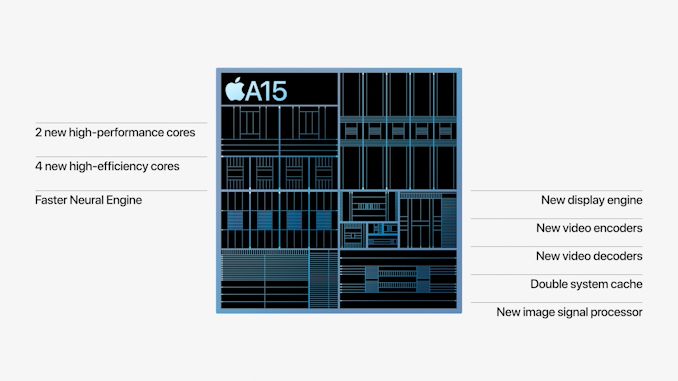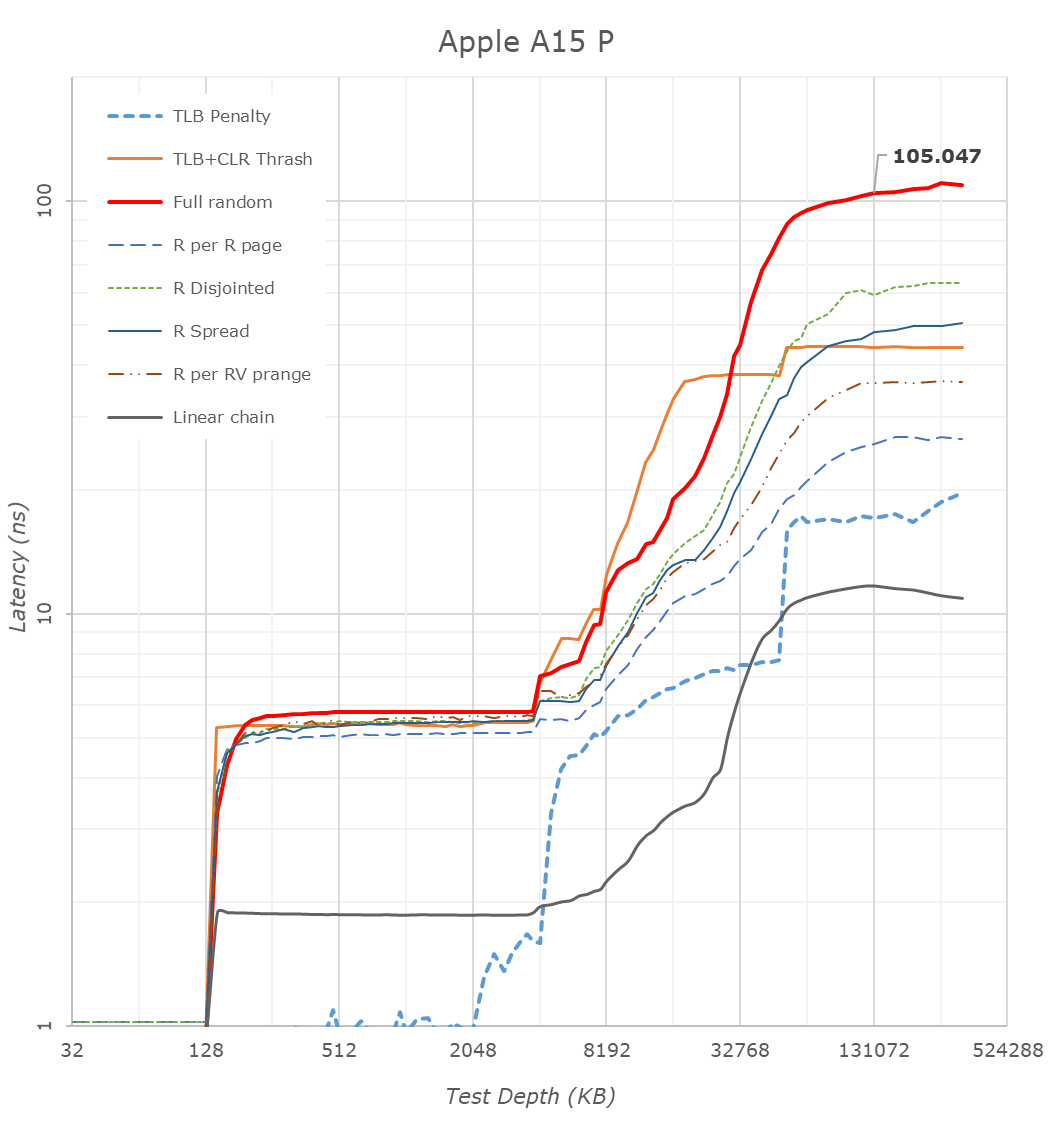The Apple A15 SoC Performance Review: Faster & More Efficient
by Andrei Frumusanu on October 4, 2021 9:30 AM EST- Posted in
- Mobile
- Apple
- Smartphones
- Apple A15

A few weeks ago, we’ve seen Apple announce their newest iPhone 13 series devices, a set of phones being powered by the newest Apple A15 SoC. Today, in advance of the full device review which we’ll cover in the near future, we’re taking a closer look at the new generation chipset, looking at what exactly Apple has changed in the new silicon, and whether it lives up to the hype.
This year’s announcement of the A15 was a bit odder on Apple’s PR side of things, notably because the company generally avoided making any generational comparisons between the new design to Apple’s own A14. Particularly notable was the fact that Apple preferred to describe the SoC in context of the competition; while that’s not unusual on the Mac side of things, it was something that this year stood out more than usual for the iPhone announcement.
The few concrete factoids about the A15 were that Apple is using new designs for their CPUs, a faster Neural engine, a new 4- or 5-core GPU depending on the iPhone variant, and a whole new display pipeline and media hardware block for video encoding and decoding, alongside new ISP improvements for camera quality advancements.
On the CPU side of things, improvements were very vague in that Apple quoted to be 50% faster than the competition, and the GPU performance metrics were also made in such a manner, describing the 4-core GPU A15 being +30% faster than the competition, and the 5-core variant being +50% faster. We’ve put the SoC through its initial paces, and in today’s article we’ll be focusing on the exact performance and efficiency metrics of the new chip.
Frequency Boosts; 3.24GHz Performance & 2.0GHz Efficiency Cores
Starting off with the CPU side of things, the new A15 is said to feature two new CPU microarchitectures, both for the performance cores as well as the efficiency cores. The first few reports about the performance of the new cores were focused around the frequencies, which we can now confirm in our measurements:
| Maximum Frequency vs Loaded Threads Per-Core Maximum MHz |
||||||
| Apple A15 | 1 | 2 | 3 | 4 | ||
| Performance 1 | 3240 | 3180 | ||||
| Performance 2 | 3180 | |||||
| Efficiency 1 | 2016 | 2016 | 2016 | 2016 | ||
| Efficiency 2 | 2016 | 2016 | 2016 | |||
| Efficiency 3 | 2016 | 2016 | ||||
| Efficiency 4 | 2016 | |||||
| Maximum Frequency vs Loaded Threads Per-Core Maximum MHz |
||||||
| Apple A14 | 1 | 2 | 3 | 4 | ||
| Performance 1 | 2998 | 2890 | ||||
| Performance 2 | 2890 | |||||
| Efficiency 1 | 1823 | 1823 | 1823 | 1823 | ||
| Efficiency 2 | 1823 | 1823 | 1823 | |||
| Efficiency 3 | 1823 | 1823 | ||||
| Efficiency 4 | 1823 | |||||
Compared to the A14, the new A15 increases the peak single-core frequency of the two-performance core cluster by 8%, now reaching up to 3240MHz compared to the 2998MHz of the previous generation. When both performance cores are active, their operating frequency actually goes up by 10%, both now running at an aggressive 3180MHz compared to the previous generation’s 2890MHz.
In general, Apple’s frequency increases here are quite aggressive given the fact that it’s quite hard to push this performance aspect of a design, especially when we’re not expecting major performance gains on the part of the new process node. The A15 should be made on an N5P node variant from TSMC, although neither company really discloses the exact details of the design. TSMC claims a +5% frequency increase over N5, so for Apple to have gone further beyond this would have indicated an increase in power consumption, something to keep in mind of when we dive deeper into the power characteristics of the CPUs.
The E-cores of the A15 are now able to clock up to 2016MHz, a 10.5% increase over the A14’s cores. The frequency here is independent of the performance cores, as in the number of threads in the cluster doesn’t affect the other cluster, or vice-versa. Apple has done some more interesting changes to the little cores this generation, which we’ll come to in a bit.
Giant Caches: Performance CPU L2 to 12MB, SLC to Massive 32MB
One more straightforward technical detail Apple revealed during its launch was that the A15 now features double the system cache compared to the A14. Two years ago we had detailed the A13’s new SLC which had grown from 8MB in the A12 to 16MB, a size that was also kept constant in the A14 generation. Apple claiming they’ve doubled this would consequently mean it’s 32MB now in the A15.
Looking at our latency tests on the new A15, we can indeed now confirm that the SLC has now doubled up to 32MB, further pushing the memory depth to reach DRAM. Apple’s SLC is likely to be a key factor in the power efficiency of the chip, being able to keep memory accesses on the same silicon rather than going out to slower, and more power inefficient DRAM. We’ve seen these types of last-level caches being employed by more SoC vendors, but at 32MB, the new A15 dwarfs the competition’s implementations, such as the 3MB SLC on the Snapdragon 888 or the estimated 6-8MB SLC on the Exynos 2100.
What Apple didn’t divulge, is also changes to the L2 cache of the performance cores, which has now grown by 50% from 8MB to 12MB. This was actually the same L2 size as on the Apple M1, only this time around it’s serving only two performance cores rather than four. The access latency appears to have risen from 16 cycles on the A14 to 18 cycles on the A15.
A 12MB L2 is again humongous, over double compared to the combined L3+L2 (4+1+3x0.5 = 6.5MB) of other designs such as the Snapdragon 888. It very much appears Apple has invested a lot of SRAM into this year’s SoC generation.
The efficiency cores this year don’t seem to have changed their cache sizes, remaining at 64KB L1D’s and 4MB shared L2’s, however we see Apple has increased the L2 TLB to 2048 entries, now covering up to 32MB, likely to facilitate better SLC access latencies. Interestingly, Apple this year now allows the efficiency cores to have faster DRAM access, with latencies now at around 130ns versus the +215ns on the A14, again something to keep in mind of in the next performance section of the article.
CPU Microarchitecture Changes: A Slow(er) Year?
This year’s CPU microarchitectures were a bit of a wildcard. Earlier this year, Arm had announced the new Armv9 ISA, predominantly defined by the new SVE2 SIMD instruction set, as well as the company’s new Cortex series CPU IP which employs the new architecture. Back in 2013, Apple was notorious for being the first on the market with an Armv8 CPU, the first 64-bit capable mobile design. Given that context, I had generally expected this year’s generation to introduce v9 as well, but however that doesn’t seem to be the case for the A15.
Microarchitecturally, the new performance cores on the A15 doesn’t seem to differ much from last year’s designs. I haven’t invested the time yet to look at every nook and cranny of the design, but at least the back-end of the processor is identical in throughput and latencies compared to the A14 performance cores.
The efficiency cores have had more changes, alongside some of the memory subsystem TLB changes, the new E-core now gains an extra integer ALU, bringing the total up to 4, up from the previous 3. The core for some time no longer could be called “little” by any means, and it seems to have grown even more this year, again, something we’ll showcase in the performance section.
The possible reason for Apple’s more moderate micro-architectural changes this year might be a storm of a few factors – Apple had notably lost their lead architect on the big performance cores, as well as parts of the design teams, to Nuvia back in 2019 (later acquired by Qualcomm earlier this year). The shift towards Armv9 might also imply some more work done on the design, and the pandemic situation might also have contributed to some non-ideal execution. We’ll have to examine next year’s A16 to really determine if Apple’s design cadence has slowed down, or whether this was merely just a slippage, or simply a lull before a much larger change in the next microarchitecture.
Of course, the tone here paints rather conservative improvement of the A15’s CPUs, which when looking at performance and efficiency, are anything but that.












204 Comments
View All Comments
Zerrohero - Tuesday, October 5, 2021 - link
I don’t know but it’s still better than anything else out there?LiverpoolFC5903 - Tuesday, October 5, 2021 - link
All that power, but what is the point? Its crippled by iOS and you can only do so much on an iphone. Can you run emulators? Can you attach standard game controllers/peripherals like you can do on android? Can you copy and paste media files from your PC into your Iphone without going through a convoluted process?If this hardware was available to android phone manufacturers, you could actually see the potential of these chips.
I believe Apple can mint money by selling their SOCs to Android smartphone manufacturers. It doesnt have to be the latest one, they could offer last years SOCs at premium prices for high end android devices. Imagine running Dolphin on a A14 or A15 powered android phone!
Zerrohero - Tuesday, October 5, 2021 - link
You have never used an iPhone.So how do you know this HW is “crippled by iOS”?
Apple itself is using this power for many very nice consumer facing features, like computational photography. Faster and more efficient prosessing, yes please.
What are those amazing power user use cases that Android allows and iOS doesn’t?
Android OEMs have shown year after year that they can’t unleash the potential of anything because they don’t own any of the relevant parts (chips, SW) and they don’t understand product design.
And yes, PlayStation and Xbox controllers work just fine in iPhone and iPad.
LiverpoolFC5903 - Tuesday, October 5, 2021 - link
Do what exactly? Browse the web? Listen to music? Do social media?I can connect controllers, mice, keyboards, external hardrives, pendrives and others via USB OTG. I can install any emulator I like from any source I want and not just play store. I can download apps from anywhere, store them and send them to other phones. I can simply copy and paste my music collection in my desktop to my phone as opposed to going through a rigamarole. I can root, install custom roms of any shape and form I like. I can completely alter the way my phone looks and functions. I can install browsers like Firefox with different engines as opposed Webkit based browsers ONLY, all of which are simply clones.
I can do so much more with my phone, you cannot possibly fathom as an iphone user.
An android phone with APple SOC would be a billion times better than an IOS phone with the same hardware in terms of overall functionality.
Nozuka - Tuesday, October 5, 2021 - link
All the things you listed will feel like a waste of time to most users, tbh. ;) (And can also cause a lot of problems)I used to like these things too in the earlier android years and i get how it can be fun. but now i just can't be bothered to spend the time. I just need a reliable and fast phone that does the most important tasks well and gets updates for a long time and stays fast. The A15 will be plenty fast for years.
And if i ever get a new device, i just want to restore without any hassle. Or if a new OS version arrives, i want to install it without fear that any of the customizations will be broken.
IMHO iOS still provides the most hassle free experience. And if the masses are missing some crucial feature it usually gets added.
But if you like to tinker around, then iOS devices are definitely not the right devices for you.
" I can simply copy and paste my music collection in my desktop to my phone as opposed to going through a rigamarole. "
I would argue that this is way more tedious than just adding the music to your library once and then it is available on all your devices.
dontlistentome - Tuesday, October 5, 2021 - link
Hey Siri/Google. Show me two people with opposing use-cases. :-)I call a draw (I can be judge, I have a 13 pro and a Pixel 5. Like both).
Spunjji - Friday, October 8, 2021 - link
Your comment speaks to my own experiences. I used to be big into Android customisation in the early days, but I gave up around about Android 5 / Lollipop when the core OS included sufficient features to be satisfying. I got extremely tired of screwing around with hacking in custom software, and my experiences with the numerous things you can *theoretically* do with an Android device were - generally speaking - poor, and not worth the effort.michael2k - Wednesday, October 6, 2021 - link
6+ years of OS updates? And before you laugh, my sister in law and mother in law both rock iPhone 6S models getting iOS 15Also you seem to be under the mistaken assumption that iOS doesn't support USB drives:
https://www.amazon.com/SanDisk-iXpand-Flash-Drive-...
External keyboards:
https://www.amazon.com/Omars-Certified-Plug-n-Go-L...
USB OTG:
https://www.amazon.com/Adapter-Compatible-Portable...
You are correct that Apple hasn't unlocked a lot of the iPhone's potential; but it's also correct that no one in Android space is willing to pay the premium necessary to come close to the iPhone's processor either. There just aren't enough people like you willing to pay enough to pay Qualcomm the extra cost of developing a faster and more powerful CPU
Nicon0s - Tuesday, October 5, 2021 - link
The same tired "you have never used an iphone argument" actually showing lack of arguments.The road for computational photography was paved by Android smaprhones not Apple.
Computational photography on the Pixel 4a with the very old SD 730 is better than on an iphone SE 2020 for example.
>What are those amazing power user use cases that Android allows and iOS doesn’t?
Well it looks like you are quite unfamiliar with Android.
Anyway a simple example is Dex and similar implementations on other phones.
Another examples is being able to use emulators and turning an Android phone into a mini console.
Aq901_22 - Tuesday, October 5, 2021 - link
> Computational photography on the Pixel 4a with the very old SD 730 is better than on an iphone SE 2020 for example.A key differences is that the SE 2020 does computational photography/videography in real time, which necessitates a decently powerful professor to execute those tasks? The Pixel 4a doesn’t have Live HDR in preview/during recording when recording videos (only in stills), nor does it have real-time Portrait Mode/bokeh control simultaneously with Live HDR nor something like Portrait Lighting control before taking a pic? The point is, the Pixel 4a has impressive computational features (like night mode, which the SE lacks) for its price.
But it’s downsides is that everything is done in post (minus HDR), and the Pixel 4a is notorious for having slower processing compared to its predecessors. So while the 4a is better than the SE 2 in stills (in low light specifically), the SE 2 has much better videography due to Apple’s obsession with doing everything in real time. And this doesn’t take into factor that the SE is also better in slow-motion, panoramas, time-lapse due to using its computational features and implementing it across the board.
The 4a is great for the price and despite using a much slower processor, it has a pretty good camera. But this also makes it have disadvantages—and this is shown across the Pixel lineup, including the 5. I say this as a huge Pixel fan and owning one.